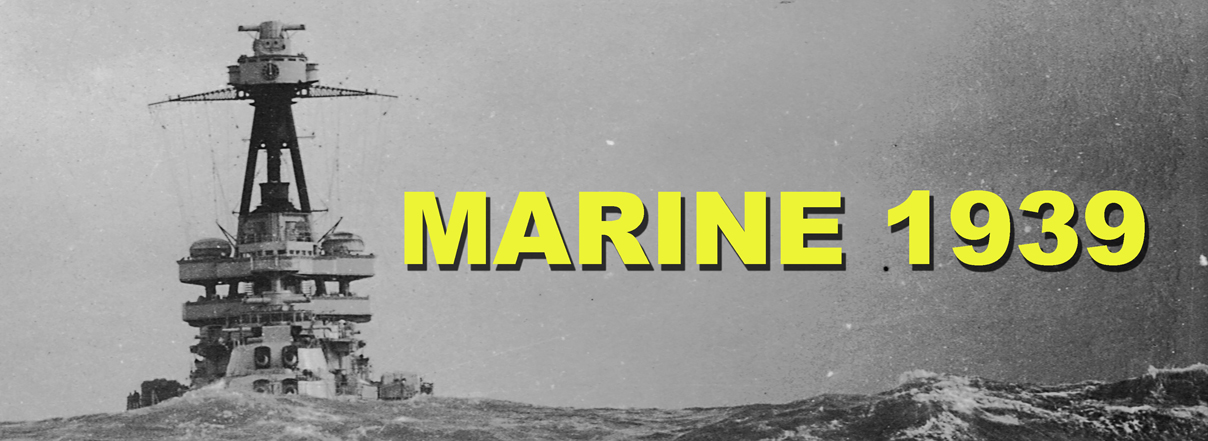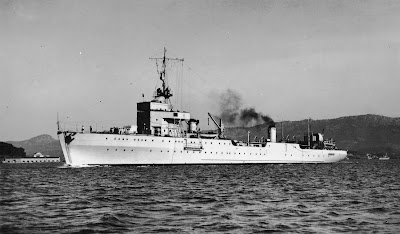Le Gladiateur à Toulon (collection Wilfried Langry)
Caractéristiques :
Chantier; Arsenal de Lorient.
Sur cale: 1932
Sur cale: 1932
Lancement:11 avril 1933
Mise en service: 1er Janvier 1935
Déplacement:1 858tW (2 293pc)
Dimensions:113,00x12,70x3,50
Puissance:7 700 CV
Vitesse:18 noeuds
appareil évaporatoire : 2 chaudières Indret
Déplacement:1 858tW (2 293pc)
Dimensions:113,00x12,70x3,50
Puissance:7 700 CV
Vitesse:18 noeuds
appareil évaporatoire : 2 chaudières Indret
Machines:2 turbines à engrenages Parsons actionnant 2 hélices
Capacité en combustible : 400 t de mazout
Capacité en combustible : 400 t de mazout
Armement en 1939:4 canons de 90 mm AA(IIx2) modèle 1926, 50 cal- 2 affûts double hotchkiss de 13,2 mm.
Equipage:132 hommes.
Equipage:132 hommes.
Historique :
Devant le développement important de la flotte française, le besoin de protéger les ports devint de plus en plus pressant. C’est dans cette optique qu’il fut décidé de construite un navire spécialisé dans le mouillage de filets de protection. Contemporain des HMS Guardian et Protector de la Royal Navy, Le Gladiateur est inscrit dans la tranche 1930 du programme naval (loi du 12 janvier 1930).
Before the major development of the French fleet, the need to protect the ports became more and more pressing. With this in mind it was decided to built a specialized ship moored in the nets. Contemporary HMS Guardian and Protector of the Royal Navy, The Gladiateur is enshrined in the 1930 portion of the naval program (law of January 12, 1930).
C’est l’Arsenal de Lorient qui est chargé de construire le navire. La mise sur cale intervient en 1932 et la coque est lancée dans l’après-midi du 11 avril 1933, en présence de l’Amiral Nielly, préfet maritime. La mise en service du navire n’interviendra qu’en janvier 1935. Il est basé à Toulon.
This is the Arsenal de Lorient which is responsible for building the ship. The setting takes hold in 1932 and the hull is launched in the afternoon of April 11, 1933, in the presence of Admiral Nielly, maritime prefect. The commissioning of the ship will occur in January 1935. He is based in Toulon.
Lors de la défaite en juin 1940, il est envoyé au Levant pour éviter une éventuelle capture. Il retournera à Toulon par la suite. Le 27 novembre 1942, il se trouve amarré dans la darse des sous-marins. Le Gladiateur est alors commandé par le capitaine de frégate Le Roch. Prévenu au dernier moment par un officier du sous-marin Caïman de l’arrivée des allemands sur le quai, il exécute l’ordre de sabordage tout en prévenant les pétroliers Rance et Durance amarrés au côté opposé du quai. Prévoyant, le capitaine Le Roch avait eu la sagesse d’obstruer l’entrée du quai, ce qui permit le sabordage du Gladiateur et de ses compagnons d’infortune sans être gênés par les allemands. Le navire se couche sur tribord et prend une gîte de 45 degrés. Le commandant Le Roch ne quittera la passerelle du Gladiateur qu’en fin d’après-midi, après avoir commandé ses hommes jusqu’au bout.
When France was defeated in June 1940, she was sent to the Levant to avoid possible capture. She will return to Toulon in the future. November 27, 1942, is moored in the dock for submarines. The Gladiateur is then controlled by Commander Le Roch. Warned at the last moment by an officer of the submarine Caïman arrival of the Germans on the platform, he executes the order to scuttle while preventing tankers Rance and Durance moored to the opposite side of the dock. Providing, Captain Le Roch had the wisdom to obstruct the entrance to the pier, which allowed the scuttling of the Gladiateur and his companions in misfortune without being hampered by the Germans. The ship lies on starboard and assumed a 45 degrees. Commander Le Roch will not leave the bridge of the Gladiateur until late afternoon, having ordered his men to the end.
 |
| Le Gladiateur couché sur tribord (Collection Wilfried Langry) / The Gladiateur lying on starboard |
 |
| Vue rapprochée du Gladiateur après le sabordage (Collection Wilfried Langry) / Closeup of Gladiateur after sinking |
Le Gladiateur évacué par son équipage, après le sabordage /
The Gladiateur evacuated by its crew after the scuttling (Bfz)
Les travaux de renflouement furent attribués à la société italienne Mario Serra et débutèrent le 10 janvier 1943 au moyen de pompes. Toutefois, la remise à flot n’interviendra que le 30 mars 1943. Après le départ des italiens suite à l’Armistice en Italie, la flotte français est partagée entre la France est l’Allemagne. Le Gladiateur fait alors partie du groupe de navires destinés à être utilisés par l’Allemagne pour la défense des côtes, et ce, pour le restant de la guerre. Sa remise en état devait être effectuée par la DIN de Toulon.
Il chavirera à nouveau au quai nord Traverse Amiral, le 6 février 1944, après avoir été endommagé lors du bombardement allié sur Toulon du 4 février.
Il sera renfloué en mai 1947 puis démoli.
She capsize again at Pier North Traverse Admiral, February 6, 1944 after being damaged during the Allied bombing of Toulon on February 4.
She will be bailed out in May 1947 and then demolished.
 |
A gauche, le Gladiateur en compagnie du Stasbourg en 1943, notez la tourelle de 90 mm avant qui a été démontée. A droite, l'épave du Gladiateur après le bombardement du 4 février 1944 / On the left, along with the Stasbourg Gladiateur in 1943, note the 90 mm turret front was removed. On the right, the wreck of the Gladiator after the bombing of February 4, 1944




Aucun commentaire:
Enregistrer un commentaire